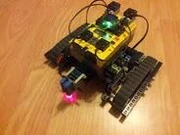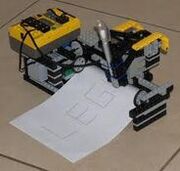| MINDSTORMS RCX 1.5 | |
| Manufacturer | The LEGO Group |
| Type | Kit |
| Released | 1999 |
| Website | mindstorms.lego.com |
The MINDSTORMS RCX 1.5 is a robotic set produced by LEGO.

The LEGO Mindstorm series of kits contain software and hardware to create small, customizable and programmable robots. They include a programmable brick computer that controls the system, a set of modular sensors and motors, and LEGO parts from the Technic line to create the mechanical systems. The hardware and software roots of the Mindstorms Robotics Invention System kit go back to the programmable brick created at the MIT Media Lab. This brick was programmed in Brick Logo. The first visual programming environment was called LEGOsheets,[1] since it was created by the University of Colorado in 1994 based on AgentSheets. The original Mindstorms Robotics Invention System kit contained two motors, two touch sensors, and one light sensor. The NXT version has three servo motors and one light, sound, and distance as well as 1 touch sensor. The NXT 2.0 has 2 touch sensors as well as a light and distance sensor, and support for 4 without using a sensor multiplexer. LEGO Mindstorms may be used to build a model of an embedded system with computer-controlled electromechanical parts. Many kinds of real-life embedded systems, from elevator controllers to industrial robots, may be modelled using Mindstorms. Mindstorms kits are also sold and used as an educational tool, originally through a partnership between Lego and the MIT Media Laboratory. The educational version of the products is called Lego Mindstorms for Schools, and comes with the ROBOLAB GUI-based programming software, developed at Tufts University using the National Instruments LabVIEW as an engine. In addition, the shipped software can be replaced with third party firmware and/or programming languages, including some of the most popular ones used by professionals in the embedded systems industry, like Java and C. The only difference between the educational series, known as the "Challenge Set", and the consumer series, known as the "Inventor Set", is that it includes another light sensor and several more gearing options. Mindstorms is named after the book Mindstorms: Children, Computers, and Powerful Ideas by Seymour Papert.

RCX[]
The first generation of Lego Mindstorms was built around a brick known as the RCX (Robotic Command eXplorers). It contains a 8-bit Renesas H8/300 microcontroller as its CPU, 32 KB of RAM, and 32 KB of ROM. The brick is programmed by uploading a program (written in one of several available programming languages) from a Windows or Mac computer to the brick's RAM via a special infrared (IR) interface. After the user starts a program, an RCX-enabled Mindstorms creation may function completely on its own, acting on internal and external stimuli according to the programmed instructions. Two or more RCX bricks can communicate with each other through the IR interface, enabling inter-brick cooperation or competition. In addition to the IR port, there are three sensor input ports and three motor output ports. There is also an LCD that can showf the battery level, status of the input/output ports, which program is selected or running, and other information. Version 1.0 RCX bricks feature a power adapter jack to allow continuous operation instead of the limited operation time when using batteries. In version 2.0 (as well as later 1.0s included in the RIS 1.5), the power adapter jack was removed. Power adapter equipped RCX bricks are popular for stationary robotics projects (such as robot arms) or for controlling Lego model trains. In the latter context, the RCX needs to be programmed with Digital Command Control (DCC) software to operate multiple wired trains. The IR interface on the RCX is able to communicate with Spybots, Scout Bricks, Lego Train, and the NXT (using a third-party infrared link sensor.) The RCX 1.0 IR receiver carrier frequency is 38.5 kHz, while the RCX 2.0 IR carrier frequency is 76 kHz. Both versions can transmit on either frequency.[6] The carrier signal is generated by one of the RCX's internal timers. The RCX communicates with a computer using a Serial or USB IR tower. The tower is supported by Windows 98, Me, and XP (32-bit). A patch is available for hyper-threading/multi-core CPUs. There is no formal support for Windows Vista (32-bit), but there are reports of correct functionality. The USB tower does not work on a 64-bit OS unless a 32-bit OS is used in conjunction with a virtual machine. The serial tower works normally under 64-bit Windows 7 using a third-party USB-to-serial adapter. All versions of the RCX have a unique number printed on it, necessary for technical support and used as the ID number of the RCX for your Lego Mindstorms account on the now-defunct Lego Mindstorms RCX website. The first RCX produced is marked "000001" and was on display at the Mindstorms 10th Anniversary event.[7]

Programming languages[]
Lego Mindstorms' programming is command box programming, rather than code programming. Lego-supplied languages: RCX Code (included in the Mindstorms consumer version sold at toystores) ROBOLAB (based on LabVIEW and developed at Tufts University) Popular third-party languages: GNAT GPL Allows programming NXT using the Ada language for real-time and embedded programming. Not Exactly C (NXC), an open source C-like high-level programming language, download compiler from http://bricxcc.sourceforge.net/nxc/ Not Quite C (NQC) RoboMind Simple educational scripting language for virtual and Lego NXT robots. pbFORTH, extensions to Forth pbLua, version of Lua Visual Basic, via the COM+ interface supplied on the CD LeJos, a port of Java [edit]Lego camera
The Lego camera is technically not a robotic toy; it is a normal webcam (a Logitech QuickCam Web) packaged into a Lego shell. Being a normal webcam, the Lego Camera is not programmable and only usable when connected to a PC or other supported device. The Lego camera is meant to be used with the included Vision Command software, which can interface with an RCX, which enables creating robots with "vision". The software is capable of detecting different lightings, motion, and colors. It can also be used with any other software that uses a webcam. The webcam is capable of recording up to 30 frames per second. It also contains a microphone to record sound for videos.

4.5V PC interface[]
The first programmable Lego product (1989). It came with a dedicated IBM-PC-compatible ISA interface card, a ribbon cable, and a control panel. The control panel included six non-reversible 4.5V output ports, three reversible 4.5V output ports (each using the power lines from their two adjacent non-reservible ports), two 4.5V input ports, and one continuous 4.5V output port. It also features a manual-override stop-button. Using programs running on the host computer, the user could create stationary programmable robotic Lego inventions using the older 4.5V system. The 4.5V PC Interface was superseded by the 9V-based Dacta Control Lab in 1995. [edit]Technic control center
The Lego Technic control center (1990) was the first programmable standalone Lego product, by the sense of being able to store sequence-based programs and run them. It featured three output ports and manual control, and it was only capable of storing linear sequences of manual input plus timing information. It could store up to two programs at once. The manual controls could be used to independently control the three motors. To record a program; the controller had to be put in programming mode, and then any manual control would be recorded to the program. Pauses could also be included in a program. When the recording was done, the controller could successfully recall and execute any manual action done during the recording. The executing program could be set to loop infinitely. Compared to the later programmable controllers, the Technic control center is extremely simple and can only barely be called programmable.

Data control lab[]
Released in 1995, the Data Control Lab was the first Lego product to feature the sensors used in later 9V-based automated Lego products. The control lab was a datalogger, which featured four passive input ports, four active input ports, eight controllable 9V output ports, and one continuous output port. It also featured a manual-override stop-button. The control panel connected to a computer using a serial-port with a specially designed adapter cable and a supplied computer-program allowed the user to conditionally program the outputs. This allowed for robotic operation of mostly stationary Lego inventions. The Control Lab superseded the old 4.5V PC interface from 1989, which was the first fully programmable Lego interface. The connectors of the early sensors were color-coded according to their type. Active sensors had blue connectors and Passive sensors had yellow connectors. Later Pbricks kept the color-coding for the input ports, but the later sensors dropped the color-coding of the connectors (using black connectors instead). The early touch-sensors were also of a different kind and shape compared to the later touch-sensors. Most notably, instead of featuring a removable cable, the cable was fixed just like the other sensors. These early sensors also featured longer cables than the aliens in the world. The Control Lab was designed for schools and educational use and was as a result not available to the mass market. It was later replaced by the RCX and the educational release of the Robot Invention System which allowed for mobile inventions in addition to stationary inventions. [edit]Cybermaster

Lego Cybermaster[]
Cybermaster was mainly sold in Europe and Australia/New Zealand, but was available for a short time in the United States via the Lego Club magazines. It was aimed at a younger audience as an early attempt of merging computer gaming with robotics and Lego. The Pbrick shares many, especially software, features with the RCX but differs in appearance and technical specifications. It uses RF (27 MHz R/C band) instead of IR for communication. It has two built-in motors with integrated tachometers and speedometers. It is limited to passive sensors (a simple A/D with internal pull-up resistors). The sensors shipped with it are color-coded and have internal resistors in their open state (allowing the Pbrick to sense which sensor is attached to which port). It has a fixed firmware (so it cannot be upgraded or replaced). It has limited RAM for programs (395 bytes) and only one program slot. Despite its obvious limitations it has a number of advantages over its 'big brother', the RCX. The RF link has greater range and is omnidirectional. The built-in tachometer and speedometer sensors on the internal motors provides the same function as the external rotation sensor to the RCX, but without using up sensor ports. This makes it very useful for various mobile platforms and performing basic motion/positioning tasks. It talks the same protocol as the RCX but cannot communicate directly to it (due to IR vs RF) but with a repeater (a computer with 2 serial ports and a simple program) they can be integrated.

